boot Citroen DS4 2017 1.G Owner's Guide
[x] Cancel search | Manufacturer: CITROEN, Model Year: 2017, Model line: DS4, Model: Citroen DS4 2017 1.GPages: 421, PDF Size: 8.79 MB
Page 126 of 421

124
DS4_en_Chap03_ergonomie-et-confort_ed01-2016
Storage box
F Raise the boot carpet for access to the storage box.
This has areas for the storage of a box of spare
bulbs, a first aid kit, two warning triangles...
It also contains the vehicle tools, the temporary
puncture repair kit...
Stowing rings
There are four stowing rings in the boot for
securing luggage:
-
t
wo are located on the boot floor,
-
t
wo are located at the aperture, in the lower
part.
03
Ease of use and comfort
Page 146 of 421

144
DS4_en_Chap04_eclairage-et-visibilite_ed01-2016
This comes on automatically when the boot is
opened and goes off automatically when the
boot is closed.
Boot lamp
The lighting time varies according to
the circumstances:
-
w
hen the ignition is off, approximately
ten minutes,
-
i
n energy economy mode,
approximately thirty seconds,
-
w
hen the engine is running, no limit.
04
Lighting and visibility
Page 257 of 421
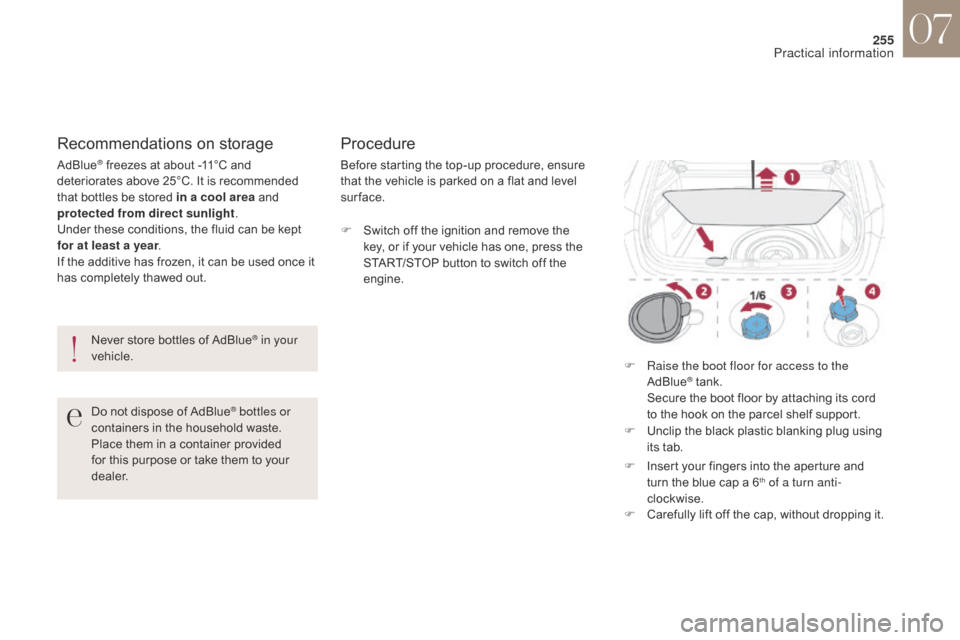
255
DS4_en_Chap07_info-pratiques_ed01-2016
Never store bottles of AdBlue® in your
vehicle.
Recommendations on storage
AdBlue® freezes at about -11°C and
deteriorates above 25°C. It is recommended
that bottles be stored in a cool area and
protected from direct sunlight .
Under these conditions, the fluid can be kept
for at least a year .
If the additive has frozen, it can be used once it
has completely thawed out. Before starting the top-up procedure, ensure
that the vehicle is parked on a flat and level
sur face.
Procedure
F Switch off the ignition and remove the
key, or if your vehicle has one, press the
START/STOP button to switch off the
engine.
F
R
aise the boot floor for access to the
AdBlue
® tank. S
ecure the boot floor by attaching its cord
to the hook on the parcel shelf support.
F
U
nclip the black plastic blanking plug using
its tab.
F
I
nsert your fingers into the aperture and
turn the blue cap a 6
th of a turn anti-
clockwise.
F
C
arefully lift off the cap, without dropping it.
Do not dispose of AdBlue
® bottles or
containers in the household waste.
Place them in a container provided
for this purpose or take them to your
dealer.
07
Practical information
Page 258 of 421
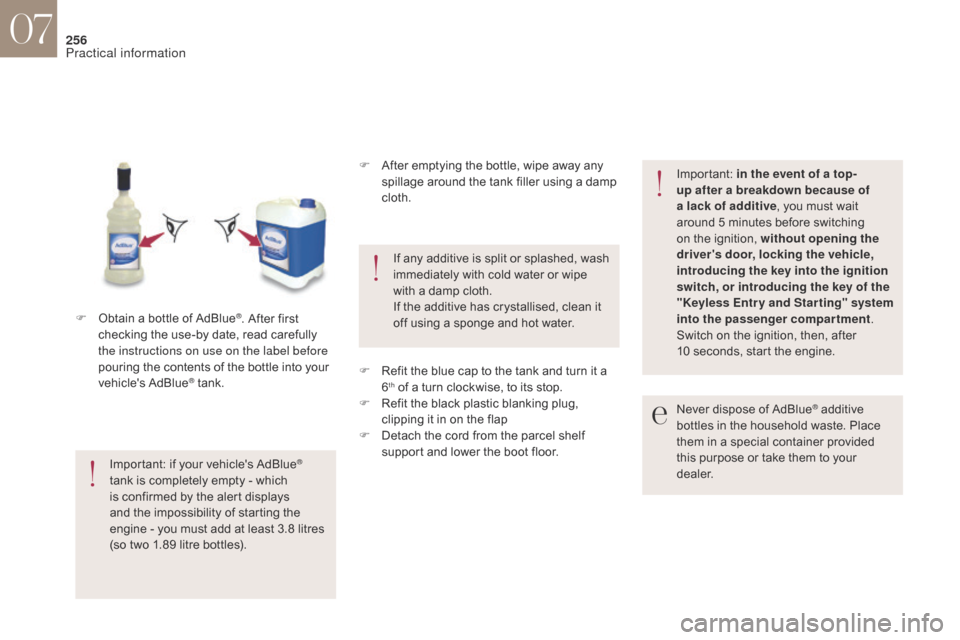
256
Never dispose of AdBlue® additive
bottles in the household waste. Place
them in a special container provided
this purpose or take them to your
dealer.
Important: if your vehicle's AdBlue
®
tank is completely empty - which
is confirmed by the alert displays
and the impossibility of starting the
engine
- you must add at least 3.8 litres
(so
two
1.89
litre bottles). If any additive is split or splashed, wash
immediately with cold water or wipe
with a damp cloth.
If the additive has crystallised, clean it
off using a sponge and hot water.
Important:
in the event of a top-
up after a breakdown because of
a lack of additive , you must wait
around 5 minutes before switching
on the ignition, without opening the
driver's door, locking the vehicle,
introducing the key into the ignition
switch, or introducing the key of the
"Keyless Entr y and Star ting" system
into the passenger compartment .
Switch on the ignition, then, after
10 seconds, start the engine.
F
O
btain a bottle of AdBlue
®. After first
checking the use-by date, read carefully
the instructions on use on the label before
pouring the contents of the bottle into your
vehicle's AdBlue
® tank. F
A
fter emptying the bottle, wipe away any
spillage around the tank filler using a damp
cloth.
F R efit the blue cap to the tank and turn it a
6th of a turn clockwise, to its stop.
F
R
efit the black plastic blanking plug,
clipping it in on the flap
F
D
etach the cord from the parcel shelf
support and lower the boot floor.
07
Practical information
Page 262 of 421
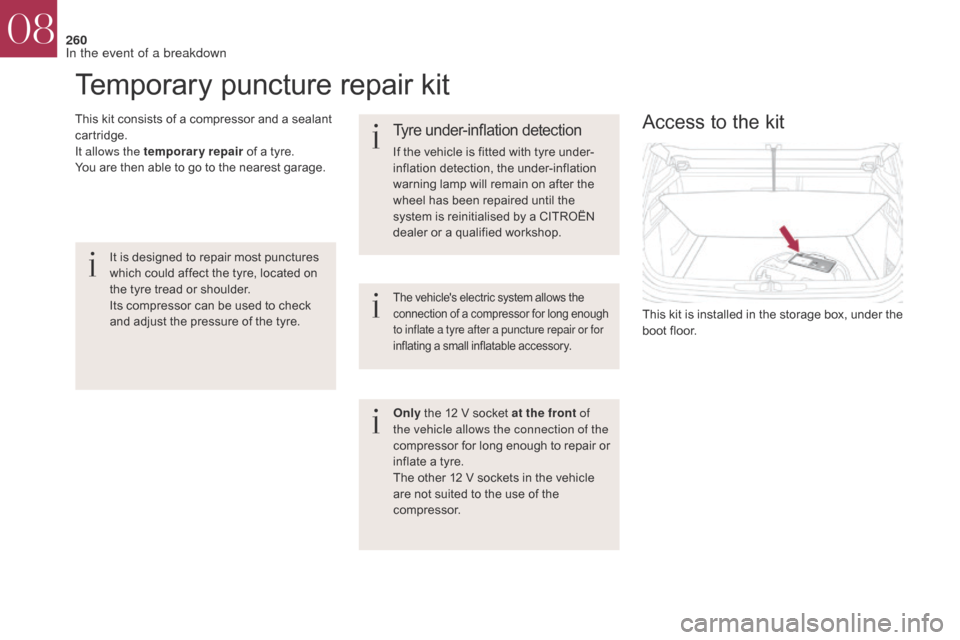
260
DS4_en_Chap08_en-cas-de-panne_ed01-2016
Temporary puncture repair kit
This kit consists of a compressor and a sealant
cartridge.
It allows the temporary repair of a tyre.
You are then able to go to the nearest garage.Access to the kit
This kit is installed in the storage box, under the
boot floor.
It is designed to repair most punctures
which could affect the tyre, located on
the tyre tread or shoulder.
Its compressor can be used to check
and adjust the pressure of the tyre.
The vehicle's electric system allows the
connection of a compressor for long enough
to inflate a tyre after a puncture repair or for
inflating a small inflatable accessory.
Tyre under-inflation detection
If the vehicle is fitted with tyre under-
inflation detection, the under-inflation
warning lamp will remain on after the
wheel has been repaired until the
system is reinitialised by a CITROËN
dealer or a qualified workshop.
Only
the 12 V socket at the front of
the vehicle allows the connection of the
compressor for long enough to repair or
inflate a tyre.
The other 12 V sockets in the vehicle
are not suited to the use of the
compressor.
08
In the event of a breakdown
Page 273 of 421
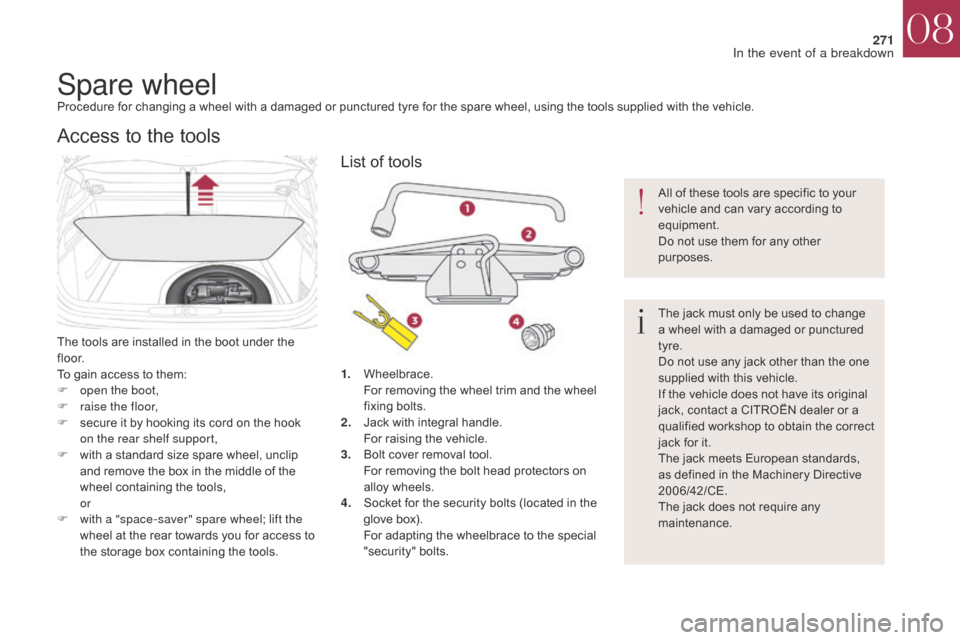
271
DS4_en_Chap08_en-cas-de-panne_ed01-2016
Spare wheelProcedure for changing a wheel with a damaged or punctured tyre for the spare wheel, using the tools supplied with the vehicle.
The tools are installed in the boot under the
f l o o r.
To gain access to them:
F
o
pen the boot,
F
r
aise the floor,
F
s
ecure it by hooking its cord on the hook
on the rear shelf support,
F
w
ith a standard size spare wheel, unclip
and remove the box in the middle of the
wheel containing the tools,
or
F
w
ith a "space-saver" spare wheel; lift the
wheel at the rear towards you for access to
the storage box containing the tools.
Access to the tools
1. Wheelbrace. F or removing the wheel trim and the wheel
fixing bolts.
2.
J
ack with integral handle.
F
or raising the vehicle.
3.
B
olt cover removal tool.
F
or removing the bolt head protectors on
alloy wheels.
4.
S
ocket for the security bolts (located in the
glove box).
F
or adapting the wheelbrace to the special
"security" bolts. All of these tools are specific to your
vehicle and can vary according to
equipment.
Do not use them for any other
purposes.
The jack must only be used to change
a wheel with a damaged or punctured
tyre.
Do not use any jack other than the one
supplied with this vehicle.
If the vehicle does not have its original
jack, contact a CITROËN dealer or a
qualified workshop to obtain the correct
jack for it.
The jack meets European standards,
as defined in the Machinery Directive
2006/42/CE.
The jack does not require any
maintenance.
List of tools
08
In the event of a breakdown
Page 274 of 421
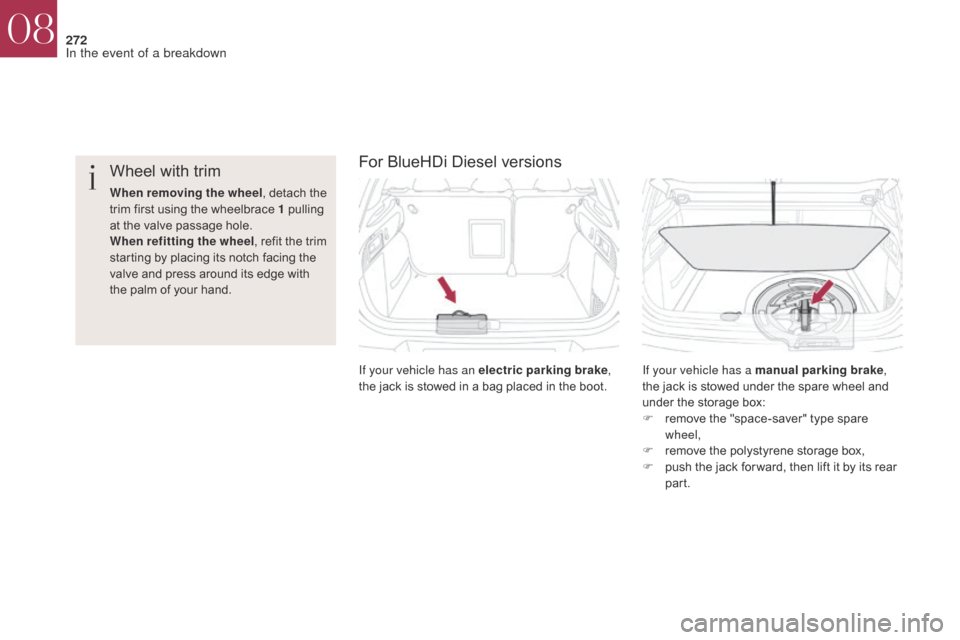
272
DS4_en_Chap08_en-cas-de-panne_ed01-2016
For BlueHDi Diesel versions
If your vehicle has a manual parking brake,
the jack is stowed under the spare wheel and
under the storage box:
F
r
emove the "space-saver" type spare
wheel,
F
r
emove the polystyrene storage box,
F
p
ush the jack for ward, then lift it by its rear
part.
If your vehicle has an electric parking brake
,
the jack is stowed in a bag placed in the boot.
Wheel with trim
When removing the wheel , detach the
trim first using the wheelbrace 1 pulling
at the valve passage hole.
When refitting the wheel , refit the trim
starting by placing its notch facing the
valve and press around its edge with
the palm of your hand.
08
In the event of a breakdown
Page 275 of 421
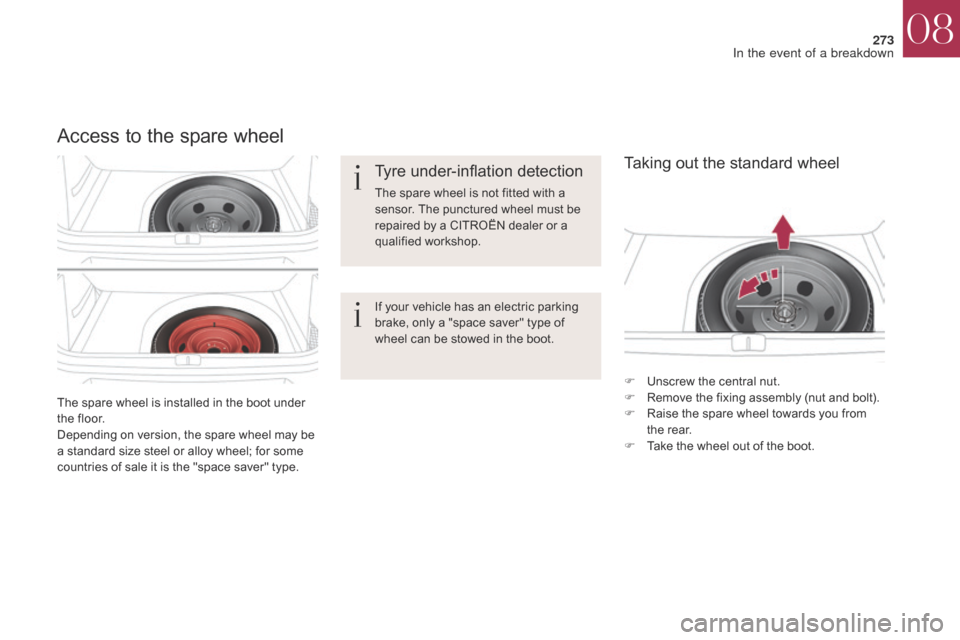
273
DS4_en_Chap08_en-cas-de-panne_ed01-2016
The spare wheel is installed in the boot under
the floor.
Depending on version, the spare wheel may be
a standard size steel or alloy wheel; for some
countries of sale it is the "space saver" type.
Access to the spare wheel
If your vehicle has an electric parking
brake, only a "space saver" type of
wheel can be stowed in the boot.F
U
nscrew the central nut.
F
R
emove the fixing assembly (nut and bolt).
F
R
aise the spare wheel towards you from
the rear.
F
T
ake the wheel out of the boot.
Tyre under-inflation detection
The spare wheel is not fitted with a
sensor. The punctured wheel must be
repaired by a CITROËN dealer or a
qualified workshop.
Taking out the standard wheel
08
In the event of a breakdown
Page 279 of 421
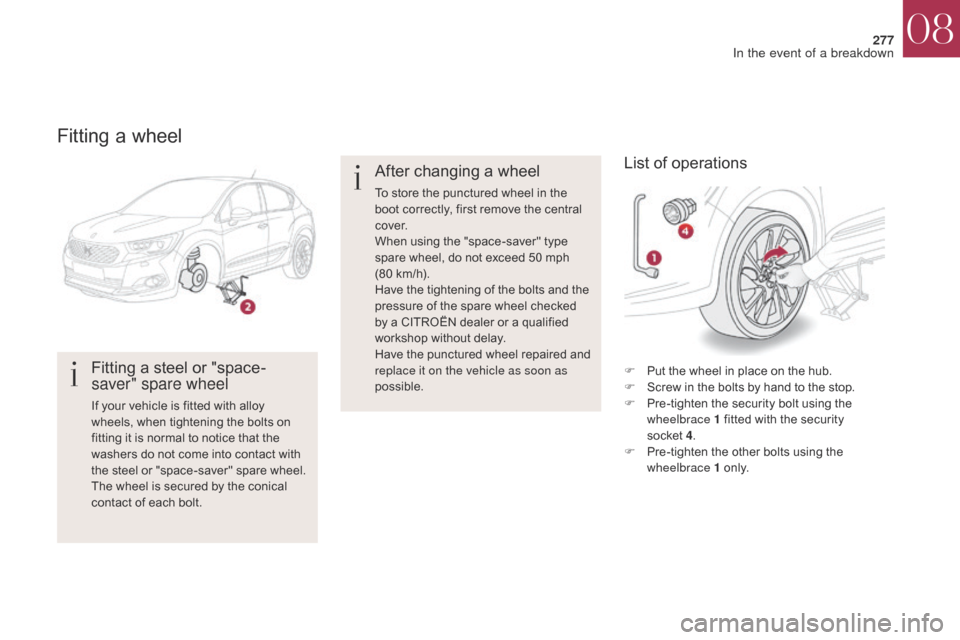
277
DS4_en_Chap08_en-cas-de-panne_ed01-2016
Fitting a wheel
Fitting a steel or "space-
saver" spare wheel
If your vehicle is fitted with alloy
wheels, when tightening the bolts on
fitting it is normal to notice that the
washers do not come into contact with
the steel or "space-saver" spare wheel.
The wheel is secured by the conical
contact of each bolt.F
P
ut the wheel in place on the hub.
F
S
crew in the bolts by hand to the stop.
F P re-tighten the security bolt using the
wheelbrace 1 fitted with the security
socket
4 .
F
P
re-tighten the other bolts using the
wheelbrace 1 o n l y.
After changing a wheel
To store the punctured wheel in the
boot correctly, first remove the central
c ove r.
When using the "space-saver" type
spare wheel, do not exceed 50 mph
(80
km/h).
Have the tightening of the bolts and the
pressure of the spare wheel checked
by a CITROËN dealer or a qualified
workshop without delay.
Have the punctured wheel repaired and
replace it on the vehicle as soon as
possible.
List of operations
08
In the event of a breakdown
Page 287 of 421
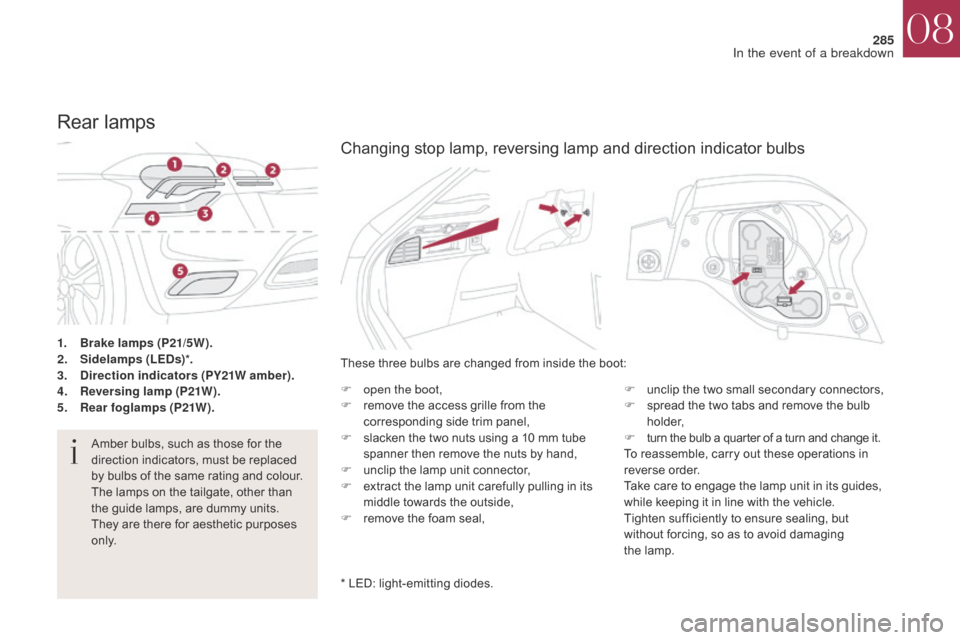
285
DS4_en_Chap08_en-cas-de-panne_ed01-2016
1. Brake lamps (P21/5W).
2. Sidelamps (LEDs) *.
3.
D
irection indicators (PY21W amber).
4.
R
eversing lamp (P21W).
5.
R
ear foglamps (P21W).
Rear lamps
Amber bulbs, such as those for the
direction indicators, must be replaced
by bulbs of the same rating and colour.
The lamps on the tailgate, other than
the guide lamps, are dummy units.
They are there for aesthetic purposes
o n l y. These three bulbs are changed from inside the boot:
F
o
pen the boot,
F
r
emove the access grille from the
corresponding side trim panel,
F s lacken the two nuts using a 10 mm tube
spanner then remove the nuts by hand,
F
u
nclip the lamp unit connector,
F
e
xtract the lamp unit carefully pulling in its
middle towards the outside,
F
r
emove the foam seal,F
u
nclip the two small secondary connectors,
F
s
pread the two tabs and remove the bulb
h o l d e r,
F t urn the bulb a quarter of a turn and change it.
To reassemble, carry out these operations in
reverse order.
Take care to engage the lamp unit in its guides,
while keeping it in line with the vehicle.
Tighten sufficiently to ensure sealing, but
without forcing, so as to avoid damaging
the
lamp.
* LED: light-emitting diodes.
Changing stop lamp, reversing lamp and direction indicator bulbs
08
In the event of a breakdown